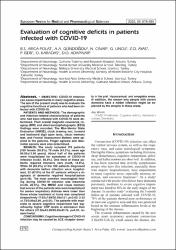| dc.contributor.author | Arica-Polat, B. S. | |
| dc.contributor.author | Gündoğdu, A. A. | |
| dc.contributor.author | Cinar, N. | |
| dc.contributor.author | Uncu, Gülgün | |
| dc.contributor.author | Ayas, Z. O. | |
| dc.contributor.author | Iseri, P. | |
| dc.contributor.author | Karadas, O. | |
| dc.contributor.author | Adapınar, Demet Özbabalık | |
| dc.date.accessioned | 2023-12-23T07:12:42Z | |
| dc.date.available | 2023-12-23T07:12:42Z | |
| dc.date.issued | 2022 | en_US |
| dc.identifier.citation | Arica-Polat, B. S., Gündoğdu, A. A., Cinar, N., Uncu, G., Ayas, Z. O., Iseri, P., Karadas, O., & Adapinar, D. O. (2022). Evaluation of cognitive deficits in patients infected with COVID-19. European review for medical and pharmacological sciences, 26(2), 678–685. https://doi.org/10.26355/eurrev_202201_27894 | en_US |
| dc.identifier.uri | https://hdl.handle.net/20.500.12900/260 | |
| dc.description.abstract | OBJECTIVE: COVID-19 infection can cause impairments in many cognitive areas. The aim of the present study was to evaluate the cognitive functions of patients who had been infected with COVID-19.
PATIENTS AND METHODS: The demographic and infection-related characteristics of patients who had been infected with COVID-19 were determined. Their cranial magnetic resonance imaging (MRI) and electroencephalography (EEG) findings were recorded. The Mini-Mental State Evaluation (MMSE). clock drawing test, forward and backward digit span tests. visual memory test. and Frontal Assessment Battery were applied to the patients. Finger agnosia and ideomotor apraxia were also determined.
RESULTS: The study included 176 patients [100 female (56.8%). 76 male (43.2%), mean age 66.09 +/- 13.96 years]. About half of the patients were hospitalized for symptoms of COVID-19 infection (n=82, 46.6%). One third of these patients required intensive care (n=26. 14.8%). While 50 (45.9%) of the 109 patients diagnosed with dementia before infection were hospitalized. 32 (47.8%) of the 67 patients without a diagnosis of dementia required hospitalization (p=0.46). The most common neurological finding during COVID-19 infection was insomnia (n=36. 20.5%). The MMSE and visual memory test scores of the patients who were hospitalized for severe respiratory distress were lower than those whose treatment at home was completed (respectively 17.92 +/- 7.69/20.59 +/- 7.01, p=0.02; 2.53 +/- 1.73/3.69 +/- 2.80. p=0.01). The patients with moderate to severe cognitive impairment had significantly higher CRP levels at admission than the others (37.52 +/- 43.09/20.93 +/- 31.74, p=0.01, respectively).
CONCLUSIONS: Cognitive damage in COVID-19 infection may be caused by ACE receptor density in the pial, hippocampal, and amygdala areas. In addition, the reason why people with severe dementia have a milder infection might be explained by the atrophy in these areas. | en_US |
| dc.language.iso | eng | en_US |
| dc.publisher | Verduci Publisher | en_US |
| dc.relation.isversionof | 10.26355/eurrev_202201_27894 | en_US |
| dc.rights | info:eu-repo/semantics/openAccess | en_US |
| dc.subject | COVID-19 Enfeksiyonu | en_US |
| dc.subject | COVID-19 infection | en_US |
| dc.subject | Bilişsel açıklar | en_US |
| dc.subject | Cognitive deficits | en_US |
| dc.subject | Alzheimer hastalık | en_US |
| dc.subject | Alzheimer’s disease | en_US |
| dc.subject | Bunaklık | en_US |
| dc.subject | Dementia | en_US |
| dc.title | Evaluation of cognitive deficits in patients infected with COVID-19 | en_US |
| dc.type | article | en_US |
| dc.department | İstanbul Atlas Üniversitesi, Tıp Fakültesi, Dahili Tıp Bilimleri Bölümü | en_US |
| dc.authorid | Demet Özbabalık Adapınar / 0000-0002-3650-2876 | en_US |
| dc.contributor.institutionauthor | Özbabalık Adapınar, Demet | |
| dc.identifier.volume | 26 | en_US |
| dc.identifier.issue | 2 | en_US |
| dc.identifier.startpage | 678 | en_US |
| dc.identifier.endpage | 685 | en_US |
| dc.relation.journal | European Review for Medical and Pharmacological Sciences | en_US |
| dc.relation.publicationcategory | Makale - Uluslararası Hakemli Dergi - Kurum Öğretim Elemanı | en_US |

















